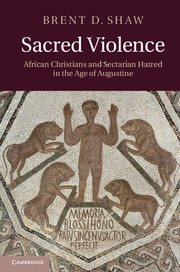Book contents
- Frontmatter
- Contents
- Abbreviations
- Maps
- Acknowledgments
- Introduction
- Chapter 1 This terrible custom
- Chapter 2 Church of the traitors
- Chapter 3 A poisonous brood of vipers
- Chapter 4 Archives of memory
- Chapter 5 The city of denial
- Chapter 6 Ravens feeding on death
- Chapter 7 Little foxes, evil women
- Chapter 8 Guardians of the people
- Chapter 9 In the house of discipline
- Chapter 10 Sing a new song
- Chapter 11 Kings of this world
- Chapter 12 We choose to stand
- Chapter 13 Athletes of death
- Chapter 14 Bad boys
- Chapter 15 Men of blood
- Chapter 16 Divine winds
- Chapter 17 So what?
- Appendix A Bishops and bishoprics in Africa: the numbers
- Appendix B Origins of the division: chronology
- Appendix C The Catholic conference of 348
- Appendix D The Edict of Unity and the Persecution of 347
- Appendix E The mission of Paul and Macarius
- Appendix F Historical fictions: interpreting the circumcellions
- Appendix G The archaeology of suicide
- Appendix H African sermons
- Bibliography
- Index
Chapter 9 - In the house of discipline
Published online by Cambridge University Press: 07 September 2011
- Frontmatter
- Contents
- Abbreviations
- Maps
- Acknowledgments
- Introduction
- Chapter 1 This terrible custom
- Chapter 2 Church of the traitors
- Chapter 3 A poisonous brood of vipers
- Chapter 4 Archives of memory
- Chapter 5 The city of denial
- Chapter 6 Ravens feeding on death
- Chapter 7 Little foxes, evil women
- Chapter 8 Guardians of the people
- Chapter 9 In the house of discipline
- Chapter 10 Sing a new song
- Chapter 11 Kings of this world
- Chapter 12 We choose to stand
- Chapter 13 Athletes of death
- Chapter 14 Bad boys
- Chapter 15 Men of blood
- Chapter 16 Divine winds
- Chapter 17 So what?
- Appendix A Bishops and bishoprics in Africa: the numbers
- Appendix B Origins of the division: chronology
- Appendix C The Catholic conference of 348
- Appendix D The Edict of Unity and the Persecution of 347
- Appendix E The mission of Paul and Macarius
- Appendix F Historical fictions: interpreting the circumcellions
- Appendix G The archaeology of suicide
- Appendix H African sermons
- Bibliography
- Index
Summary
If violence and hatred were as ordinary and as old as Africa itself, they were now urged along in new modes by the novel figure of the Christian preacher. The preacher's sermon is one of those mundane things that is so ordinary in our experience that its invention and impact has often flown beneath the level of our attention. In communicating a mass of new ideas, the Christian sermon had no precursor or equal. Nothing like it had existed. It had to be created. The need for the new vehicle was considerable since in the mass popular communications of the time there was necessarily a constant interplay between the written text, the iconic picture, and the spoken word. There were numerous ways in which these different media could be connected and negotiated, but it was usually assumed that they would somehow be linked. In a world where most persons were illiterate, it was everyday knowledge that there would have to be a constant transcription of the fixed written text, through various channels of oral transmission, to listeners. It was at the critical juncture between the Holy Scriptures of the faith on the one hand and their transmission and interpretation to large numbers on the other that the figure of the preacher was situated.
To succeed, the preacher had to be an attentive listener, carefully attuned to his audience. It must have been a difficult task in some cases, with an audience so varied and complex in its makeup. In the case of the rules or canons decided upon by African church councils, for instance, it was assumed that the main audience for the decisions would be listeners who would acquire knowledge of the new rules by hearing them. Despite other types of teaching, preaching was the main means by which such important things were to be heard. In speaking of the ways in which the behavior of widows and widowers might be controlled, Gratus, the Catholic Primate of Africa in the mid-350s, remarked that the rules governing these vulnerable women and men were enforced within the Christian community “by unrelenting preaching and by constant verbal warnings.” The powerful impact of sermons ran deeper than any text. Even imperial laws had to be proclaimed. No matter how widely distributed and publicly posted, and occasionally read aloud on market days, they were still written texts whose base was the transcribed form. The Christian sermon was a far more effective means of bridging the running space between written and oral. Even when based on written texts, the whole aim of the sermon was focussed on oral delivery. In his letter to the imperial official Bonifatius in 417, Augustine remarked that the sermons of Catholic preachers were trying to persuade in the same manner as imperial laws were trying to convince. The sermons, both Catholic and dissident, were achieving this persuasion in a fundamentally different manner.
- Type
- Chapter
- Information
- Sacred ViolenceAfrican Christians and Sectarian Hatred in the Age of Augustine, pp. 409 - 440Publisher: Cambridge University PressPrint publication year: 2011

